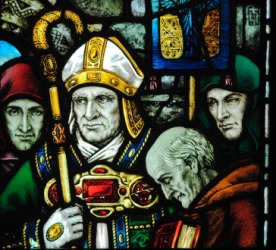1. Why
do we give Easter Eggs at Easter and what do they represent?
In many
ancient cultures, eggs were a common symbol new life and immortality. In
medieval times, Christians adapted the egg to their own religious devotions by
giving up the eating of eggs during Lent and resuming it after Easter. Eggs
came to represent the Lord's resurrection -- just as Christ broke out of the
tomb on Easter morning, the yolk of the egg breaks out of its shell when
cracked. The decoration of eggs for Easter is part of the folk traditions of
many cultures, although it has little or no religious significance any more.
The Easter rabbit is a popular secular symbol for Easter that has never taken on a Christian interpretation. It seems to have originated from the hare, a symbol of fertility in ancientEgypt
and later on in parts of Europe . It is not
altogether clear how the Easter rabbit became associated with the laying of
eggs.
The Easter rabbit is a popular secular symbol for Easter that has never taken on a Christian interpretation. It seems to have originated from the hare, a symbol of fertility in ancient
2. What
are the origins of the Easter Bunny and the Easter Egg?
In the
Northern Hemisphere Easter occurs in the spring, and coincides with pagan
rebirth and fertility festivals.
Eggs have
been a symbol of new life and resurrection since ancient times. Rabbits too
have for long been associated with the the fertility of spring because they
themselves are so fertile. When early Christians moved into pagan areas
they realised that it would be impossible to change the ingrained ancient
beliefs. Instead, they adapted them and Easter became a mixture of both
Christian and pagan customs.
3. Origins,
Dates and Days of Easter
The date
on which Easter falls varies from year to year. Easter falls on the Sunday
after the ecclesiastical Full Moon that falls on or after March 21. Easter is
therefore observed between late March and late April and can extend to early
May in the Eastern Christian churches.
A system for calculating
the dates for Easter was begun around 532 AD when a Scythian monk named
Dionysius Exiguus reconciled the Eastern and Western church calendars with the
Julian calendar, established by Julius Caesar. Dionysius Exiguus established
the date of Christ's circumcision at 1 January, 1 AD, or Anno Domini,
translated as 'the year of our Lord'. While this calendar was adopted by the
Church, the old Julian calendar remained in civil use for another thousand
years. Eventually, these were reconciled with the current Gregorian calendar,
adopted in 1582.
We know that
Easter was being observed as early as 180 years AD. The first black African
Pope, Pope
Victor (189-199 AD) decreed that Easter should be celebrated on a Sunday.
However, churches in different regions, such as those represented by a synod of
Asiatic bishops, celebrated Easter on different dates, not always on Sundays.
The Council
of Nicea (AD 325) finally clarified this by stating that Easter would be
celebrated on Sundays.
A Christian
scholar, the Venerable Bede (672-735 AD), first asserted
that Easter was named after Eostre, the Great Mother Goddess of the Saxon
people in Northern Europe . Her name was
derived from the ancient word for spring, eastre. Pagan festivals
associated with birth, the renewal of life, fertility and sunrise date back
long before Christianity. Pagan religions in the Mediterranean area are
recorded as having a major seasonal day of religious celebration at or
following the Spring Equinox. Many of the present-day customs of Easter have
their origins in these festivals.
4. Religious
Observances
There are a
number of observances and feast days related to Easter.
Palm
Sunday celebrates Jesus's triumphant entry into Jerusalem. In many
churches, during Palm Sunday services, large palm branches are carried in
processions. Members of the congregation also hold small crosses made of palm
leaf. The palm leaves are a reminder of when the people of Jerusalem waved palm
leaves when Jesus arrived in Jerusalem, and to remember the cross on which he
died.
Ash
Wednesday draws on the ancient Biblical traditions of covering one's head
with ashes, wearing sackcloth, and fasting. The use of ashes, made by burning
palm crosses from the previous Palm Sunday, is very symbolic. Some churches
hold special services at which worshippers are marked on the forehead with a
cross of ashes as a symbol of penitence and mortality.
Lent
is the period of forty days which comes before Easter, beginning on Ash
Wednesday. Lent is observed as a time for prayer and penance recalling the
events leading up to Jesus' crucifixion. Only a small number of people today
fast for the whole of Lent, although some maintain the practice on Ash
Wednesday and Good Friday. Purple drapes and altar frontals are used in some
churches throughout Lent, because it is associated with mourning and so anticipates
the pain and suffering of the crucifixion. Purple is also the colour associated
with royalty, and celebrates Christ's resurrection and sovereignty. Most
Christians regard Jesus' time 40 days fasting in the wilderness as the key
event for the duration of Lent.
Christians
remember Maundy
Thursday as the day of the Last Supper, when Jesus washed the feet of his
disciples and established the ceremony known as the Eucharist. The night of
Maundy Thursday is the night on which Jesus was betrayed by Judas in the Garden of Gethsemane
Easter
Sunday is the commemoration of the resurrection of Jesus Christ and is
celebrated with great enjoyment by Christians. Churches are usually filled with
flowers and the celebrations include the singing of special hymns.
Ascension Day
marks the last earthly appearance of Christ after his resurrection. Christians
believe Christ ascended into heaven. It is celebrated 40 days after Easter.
Pentecost
is celebrated on the seventh Sunday after Easter. Pentecost comes from a Jewish
harvest festival called Shavuot. The apostles of Jesus were celebrating this
festival when the Holy Spirit descended on them. Pentecost marks the birth of
the Christian Church
5. Easter
Traditions
Shrove Tuesday or Pancake Day
Shrove Tuesday
is the last day before Lent. In earlier days there were many foods that
observant Christians would not eat during Lent such as meat and fish, eggs, and
milky foods. So that no food was wasted, families would have a feast on the
shriving Tuesday, and eat up all the foods that wouldn't last the forty days of
Lent without going off.
Pancakes became
associated with Shrove
Tuesday because they were a dish that could use up perishable foodstuffs
such as eggs, fats and milk, with just the addition of flour. Pancake races are
thought to have begun in 1445. A woman who was busy cooking pancakes in her
kitchen lost track of the time on Shrove Tuesday and when she heard the church
bell ringing, she woman raced out of her house and ran all the way to church;
still holding her frying pan and wearing her apron.
Many Australian
groups and communities make and share pancakes on Shrove Tuesday. Selling
pancakes to raise money for charity is also a popular activity.
6.
Popular Symbols of Easter
Easter Eggs
Eggs, symbolizing
new life, have long been associated with the Easter festival. Some families and
community groups organize Easter egg hunts for children in parks and
recreational areas. Easter eggs are traditionally eaten on Easter Sunday,
however stores start stocking Easter treats well before the Easter holiday
period.
The Easter Bunny
Early on Easter
Sunday morning, the Easter
Bunny 'delivers' chocolate Easter eggs to children in many parts of the
world.
The rabbit and
the hare have long been associated with fertility, and have therefore been
associated with spring and spring festivals. The rabbit as a symbol of Easter
seems to have originated in Germany Germany












